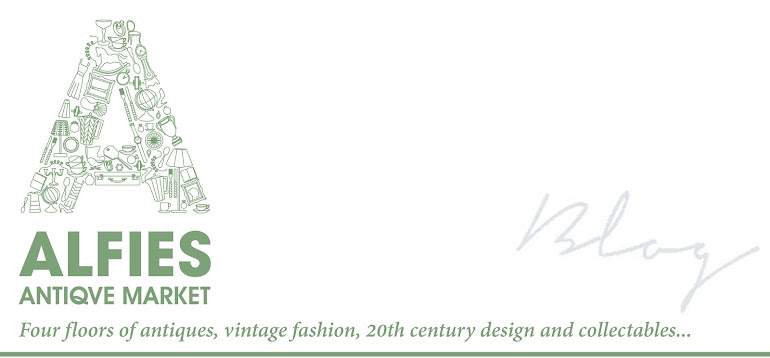 |
| June Victor at her Stand (SO40-43) |
June Victor is a world renowned antiques dealer specialising in textiles and home furnishings. She has a wide collection that includes table linen, lace, dress textiles and furnishings, trimmings and beading, costume jewellery, vintage clothing, hats and ladies’ accessories spanning over 200 years of British and European design. Her knowledge has been honed through years of experience in the antiques trade and her family’s background in couture and design. She has been a dealer at both Grays and Alfies for almost thirty years. I have read that June Victor can spot a genuine 1950's scalloped edged, taffeta ballet length designer evening dress at a hundred paces...
We were fascinated to know how June started and evolved in the word of vintage textiles, so we asked her about her life and Vintage Modes..
June, would you please tells us something about your background?
I came from a background of people that were interested in textiles. My grandmother had a couple of dress shops in the 1920s, on Shaftesbury Avenue, selling beaded dresses and hats. Two of my aunts were dress designers. They used to buy sample beaded dresses in France and reproduced what they saw for the London market. My aunt made cocktail dresses and wedding dresses in the 50s, 60s and 70s under the name of Laura Phillips in Margaret Street.
How did you fit into this?
I worked in the family business mostly in administration and management. In fact I started life as a secretary, but it wasn’t really my thing. Then I got a taste for buying in jumble sales, as they were then, and I started selling. I had a small stall in a market in Brighton in the local Hall, and I was quite successful. I used to run around Sussex buying things. In those days you could buy lovely things. No car, just buses and trains.
What do you look for when you buy?
It changes over the years and I have a lot of stock. There’s more people in the business now and it’s more competitive. I used to do all the markets, and I am doing a lot of work with theatre, opera and film production. But I never did any dressmaking myself. I don’t know how to sew. My aunt had a natural talent, she could make a dress out of nothing. To give you an example, one day her mother went out to the shops and when she came back she found that my aunt had made a dress with a piece of fabric she had found. She did it without a pattern and she was only fourteen years old. She was incredibly skilled. It’s a marvellous talent. I recognise the differences in beadwork but I mostly buy Victorian beadwork which is a different technique to the beaded dresses of the early twentieth century.
Given your vast knowledge, what element makes up your mind what you actually buy?
I have to think about my customers. A lot of them come from theatre, opera and film production. Different people with different aesthetic requirements and different briefs come to me. And you just can’t buy enough trimmings. I am always looking to buy more trimmings and beading of different styles or period. Hats are quite popular at the moment. But I buy a lot on personal likes and dislikes. Even if something looks like it would sell, I don’t buy it because I won’t have the enthusiasm to sell it.
Would you choose one item for us that you are particularly fond of?
This Edwardian bedspread in ecru colour is especially nice. It’s probably from France or Belgium. It has filet lace with cherubs and flower motifs and is interspersed with fine silk net.
 |
| Edwardian Bedspread |
 |
| Close up of the filet lace with cherubs and
flower motifs and is interspersed with fine silk net. |
 |
| Victorian Indian Table Cloth on Silk Shantung unused with gold thread work decoration. |
 |
| 1980's Canadian Couture Cocktail Dress with lace stain bow lace bodice. Estrid Toronto. |
 |
| 1930's Satin Black background embroidered with silk flowers and gilt chain |
 |
| Late Victorian Crazy Patchwork Silk Quilt Cover |
 |
| The above image is a close up of the makers name and date finished 1890. |
 |
| Circa 1910, Royal Blue all-over fringed in blue beads tassel bag. |
 |
| Black Lace Stilettos with gold rim heels. |
Interviewed 16th August 2018 by Titika Malkogeorgou

























